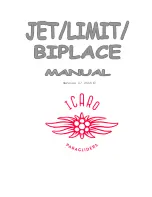
28
For a normal, into-wind landing evenly pull the brakes all the way down when you are close to
the ground and straighten up to land on your feet. The glider will stop almost completely as the
brakes are fully applied. Under nil-wind conditions, or if you are forced to make an emergency
downwind landing, a wrap on each brake will allow you to make a stronger flare.
Avoid landing directly out of a turn or wing-over since the momentum of the pilot will be much
greater due to the pendulum effect.
Attention
:
After touching down do not allow the glider to dive overhead and fall in front of you. If the
leading edge hits the ground hard the structure of the cell walls may become damaged.
i.
Towing and winching
When towing or winching, the glider must be above the pilots head before starting.
In the initial phase the tension should not be too high – a pilot climbing at a flatter angle has
more control.
Tension of more than 90kp is not allowed. In any situation, the maximum permitted tension on
the line must not exceed the pilot’s weight.
The pilot must be informed and aware of the national requirements for towing. This includes
matter such as; tow/winch licence requirements, qualified tow operators, suitability of glider
for towing, if winch and towing-links are certified etc.
In general, the regulated and enforced regulations must to be followed.
j.
Asymmetric and frontal collapses
The RISE will normally re-inflate after an asymmetric collapse without input from the pilot, but
the wing may turn towards the collapsed side. To support the reopening it´s recommended to
pull the brakes on both sides.
You should always maintain course and direction by weight-shifting away from the collapsed
side. This can be reinforced by applying a small amount of brake on the opposite side to the
deflation. If the collapse stays in, the glider can be re-inflated by pumping the brake on the
collapsed side in a firm and smooth manner. Be aware that the brake travel is shorter when the
glider is collapsed and the glider can stall with less brake input.
If you experience a big collapse while accelerated, the canopy will fall behind you due to the
difference in inertia between the pilot and the canopy. You must wait until you pendulum back
under the canopy before dealing with the deflation. Reacting too early can risk stalling the
glider completely. Release the speed-bar immediately if you have a big collapse during
accelerated flight and, while keeping weight-shift neutral, apply slight brake to the open side.
Let the glider enter a turn if space allows in order to avoid a spin or stall.
3-Line gliders have sometimes the tendency to reopen slowly after a frontal collapse. To
support the reopening of a frontal collapse you can pull both brakes equally.
Содержание RISE
Страница 21: ...37 A ANHANG ANNEX a Leinenplan line plan ...
Страница 24: ...40 C EBL DDP ...
Страница 25: ...41 ...
Страница 26: ...42 ...
Страница 27: ...43 ...
Страница 28: ...44 ...
Страница 29: ...45 ...
Страница 30: ...46 ...
Страница 31: ...47 ...
Страница 32: ...48 ...
Страница 33: ...49 ...













































